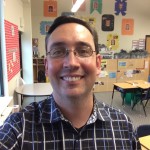Imagine beginning day one of a unit of inquiry with nothing but a blank planner. Learn how two grade 5 teachers pushed the limits of inquiry-based design by planning, communicating and implementing a completely student-developed unit of inquiry event with collaborative input from parents, students and administration.
For our third unit of inquiry How we express ourselves, we wanted to push the limits of inquiry-based design: develop a truly student-created unit with input from parents, teachers and administrators. After working diligently to gain endorsement from all community stakeholders (students, parents, administrators and specialist teachers), we made plans for a collaborative planning session on the first day of our unit: three rotations led by teachers and administrators featuring students and parents working together to produce a brand new central idea, lines of inquiry, and summative assessment based on the vague idea, “people express creativity with technology.”
We carefully balanced each group so that parent and student ideas were equally represented. Student engagement level rose as they started to see the unit developing as we progressed from central idea to lines of inquiry to the summative project. In the end, we blended the best of the ideas from each of the three groups and came up with the following, completely from scratch:
- Central idea: Technology enables individual expression while diversifying interactions with others.
- Lines of inquiry: How different forms of technology give us ideas; How technology changes people’s interactions; and How technology use varies in different cultures.
- Summative experience: Students will express themselves by creating through their choice of a technology platform, such as: blog, computer program, digital animation, video, website, etc. The students will then share this information internationally through worldwide connections. Students will work independently or in a group, with groups based on a common interest in a particular platform and will, hopefully, share their creations with people in different locations throughout the world.
As the unit began, we emphasized the student-created activities from the planning session, which led to a level of student ownership previously unprecedented in our experience. Throughout the unit, students referred to it as “their unit” and were heavily invested in each experience. At the end-of-unit open house, we created a video highlighting all of the learning experiences throughout the unit and students shared their summative projects, bringing the entire experience full circle. The student’s ownership of their learning and pride in what they had created was evident in every facet of the event, and we heard from parent after parent how much they had learned about the process; how much better they understood units of inquiry; their new-found appreciation of the PYP curriculum in general; and their understanding of the motivations for creating units and the connections between them. Our Blank Planner Project had been a success and everyone involved was able to identify a positive takeaway.
We used this experience to scaffold the necessary skills for the PYP exhibition at the end of the year. The Blank Planner Project allowed parents and students to develop one unit of inquiry for the entire grade. During the exhibition, our students worked under the theme Who we are, but developed many small group units of inquiry. Last year, we had 27 students who divided into 11 groups based on different central ideas and each child focused on one line of inquiry. Our students used this scaffolding to prepare for a successful, independent and inquiry-based exhibition process. During the eight-week exhibition, students completed 83 community-based action steps and displayed mindfulness of their growth as learners throughout their PYP experience!
In the end, there were clear, positive outcomes for everyone involved in the Blank Planner Project. Students enjoyed the opportunity to create their very own unit, displaying previously unseen pride and ownership in their learning experience, and were set up for success in the exhibition later in the year. Parents participated in the planning process of a unit and witnessed the successful end results, while gaining a deeper understanding and appreciation for the Primary Years Programme and student-led, inquiry-based learning. Even our administration gained a new appreciation for what our students are capable of and the many ways we can continue to strengthen the connections between all constituents in our school community. Finally, we as teachers found this to be an incredible opportunity to stretch our own understanding of what is possible in inquiry-based instruction. We hope that sharing this experience and our story inspires you to try new adventures and experiments with your own Blank Planner Projects in the future!
—
Trevor Lindsay has fourteen years of experience teaching in independent schools, including eight years of PYP. Stacey Walker has taught within the PYP for seven years, including an internship in South Korea. She is currently gaining a master’s in Educational Leadership. Between both teachers, they have taught all PYP grades, Kindergarten through grade 5. As a current grade 5 team, they have strived to create meaningful inquiry-based opportunities to prepare students for the PYP exhibition. They are passionate about differentiation, innovation and mastery-based education. Collectively, they are motivated to empower students to take ownership of their learning through inquiry and raise student achievement and engagement.


